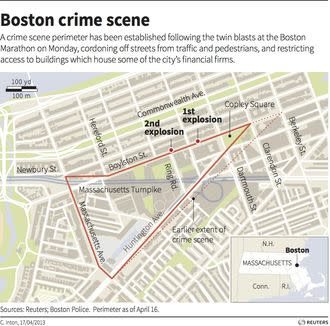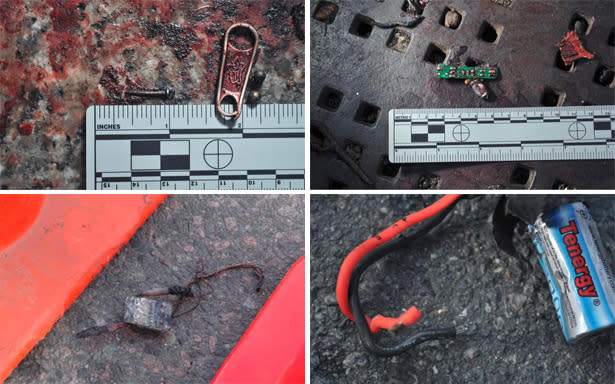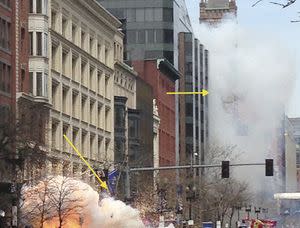New Boston Bomb Parts and Crime Scene Photos Provide Early Marathon Answers
As the investigation into the Boston Marathon bombing entered its third day, forensic specialists with the FBI, the ATF, and local law enforcement continued to review countless amounts photo and video evidence. And while officials asked citizens to help find the suspect and Internet gurus helped make sense of the "bag or backpack" holding the explosives, important details have emerged from the "ends of the Earth" effort to understand the bombs themselves. At a press briefing early Tuesday evening, FBI special agent in charge of the investigation Richard DesLauriers said analysts at headquarters in Quantico were examining black nylon that could be from a backback which appeared to contain BB guns and nails, "possibly" in a pressure cooker device. Later Tuesday evening, the FBI released two photos — a scrap of black nylon and a hunk of metal — and by Wednesday morning more images had emerged: pictures of the debris from the explosions taken by investigators that combined to become, well, bomb parts. The FBI will try to reconstruct the bomb for answers, and the next briefing is scheduled for early Wednesday afternoon, but as the investigation moves from its "infant" stages to immediate forensics analysis that could lead to answers, the bomb parts and the crime scene itself provide an early public assessment for this crowdsourced investigation.
RELATED: Refusing to Be Terrorized by Terror
The Color of Smoke: High or Low Explosives
One of the biggest early indicators in the investigation comes from photos: the color and density of the smoke may be indicative of a certain type of bomb. Dr. Adam B. Hall, a forensic chemist, told The New Yorker's Paige Williams that the very white color in photos would indicate a "high" explosive such as an ANFO (ammonium nitrate, or fertilizer, plus fuel oil) or T.A.T.P (triacetone triperoxide, a mixture of commercially available acetone, hydrogen peroxide, and something acidic, like vinegar). Michael Marks, a Naval Criminal Investigative Service retiree, says investigators should be analyzing multiple colors, he told Wired's Danger Room. "I'm seeing both dirty grey and white," he said. To him, dirty grey would suggest a high explosive, whereas "bright white" would suggest gunpowder, which sources tell ABC News was used in at least one bomb. (Reuters reported both gunpowder and schrapnel were used.) However, one law enforcement official described the bombs as a "low explosive" to CBS News. Of course, it's possible that the two bombs were made from different materials. But both of these experts concede that they're too far away from the scene to really know. The crowdsourced photos pouring out of the Internet — like this giant spreadsheet of Flickr photos geotagged at the location and video clips at the scene — as well as eyewitness accounts could bring more clarity. Already one group claims to have found a photo of pressure cooker lid on the roof of a building — the AP reports it's been recovered by authorities — and 4chan and Reddit are on the case with the photos.
RELATED: Saying Something About Boston
The New Photos: Detonator Clues, a Battery, and an Energy Drink
RELATED: Reddit and 4Chan Are on the Boston Bomber Case
By Tuesday afternoon there were multiple theories about how the bomb went off. It's still unclear how that happened, but the latest photos provided to Reuters by the Boston Joint Terrorism Task Force (above) show, in addition to energy drinks and BBs and nails, "a few inches of charred wire attached to a small box." And another shows a "Tenergy brand battery attached to black and red wires through a broken plastic cap." Still, authorities have not yet determined the fusing system for the devices or what exactly set them off, notes ABC News — and there may be fewer clues made public than images and armchair experts can tell. But there may be links to a circuit board, recovered and reported by The Boston Globe as a possible detonator. (Law enforcement officials refused to elaborate at the last briefing, perhaps a telling sign.)
RELATED: China Mourns the Third Boston Bombing Victim, Now a Mystery in All but Name
Hall, the forensic chemist, suggests investigators use caution when investigating these parts. "The problem with this is, there were so many people in the area, there’s trash, water bottles, newspapers blowing all over the place, so if you find electronic components, is it the cell phone of a victim or is that something that was part of the original device?" This is just the earliest phase of forensics, albeit at a rapid pace. In a post on his public Facebook page Tuesday, the White House counterrorism veteran Richard A. Clarke outlined how the process usually goes from here:
FBI (perhaps with help from ATF) will try to reassemble the bombs by gathering as many tiny fragments of material as possible., as they did in the case of the bombing of Pan Am 103 and Oklahoma City. Already they have informed guesses about the explosive material and the fragmentation material. They will collect fragments from the buildings, the temporary crowd control fence that lined Boylston Street and, regrettably, from the severed limbs of the victims. Next, the FBI will try to determine if a bomb design was used based upon a specific “how to make a bomb” web page on the Internet. Law enforcement authorities will try to determine where the bomb materials and the back pack or other carrying case were purchased.
The Sound: Crack or Boom?
RELATED: This Is What Boston Heroism Looks Like
"Higher explosions tend to give a very loud crack rather than a low-toned boom," said Hall, the chemist. Forensic specialists — there are 30 on site for the ATF and Boston law enforcement focusing on the clips, the ATF's Gene Marquez sai Tuesday — will continue to watch footage to determine what the sound can tell about the sophistication of the devices. Hall also says that they want to know if was a "subsonic" or a "supersonic" explosion. "Is it greater than or less than the speed of sound? Let's say you’re at a fireworks demonstration and you see the explosion and then hear the boom. That means the speed of light is faster than the speed of sound."
The Speed of the Explosion
High explosives have detonation velocities of over 15,000 feet per second, meaning that one second after such a device activates, its pieces could travel 15,000 feet from the blast. That's why, as you can see to the right, the perimeter of the crime scene at first extended fifteen blocks. Since, they have condensed it a bit to 12 blocks.
The Smell of Explosion: Sulfur or Gasoline?
A sulfur smell would again confirm gunpowder. One person at the scene claimed the smell of sulfur was overwhelming. However, another person said that "it was hard to pinpoint the exact smell of the explosion." A witness told Time the same: "But it just smelled like an explosion, smelled like chemicals."
Beyond the Crime Scene: What's Next?
DesLauriers, the FBI agent, said the investigation will "be pursued methodically, diligently, but with a sense of urgency." So we'll probably get more details at Wednesday's press briefing, but as Clarke explained, there are other facets beyond bomb technology: Phone records will be searched for calls from suspicious numbers and locations; cell phones as a detonation device may be explored; there may be flight information of people coming in and out of Boston to suspicious locales; there are no doubt informants on the ground; there is the fringe message board sector of the Internet; and, to be sure, there are thousands if not millions of private citizens willing to lend a hand. Stay tuned right here for updates on Day Three in Boston.




